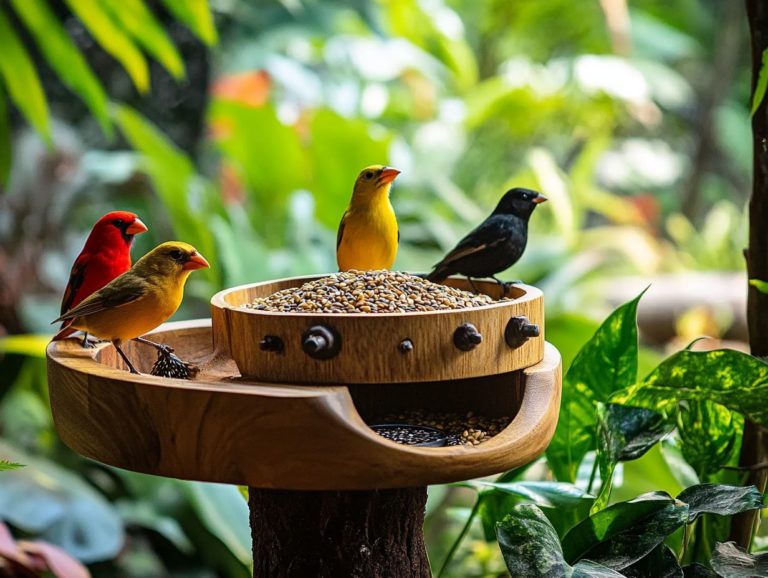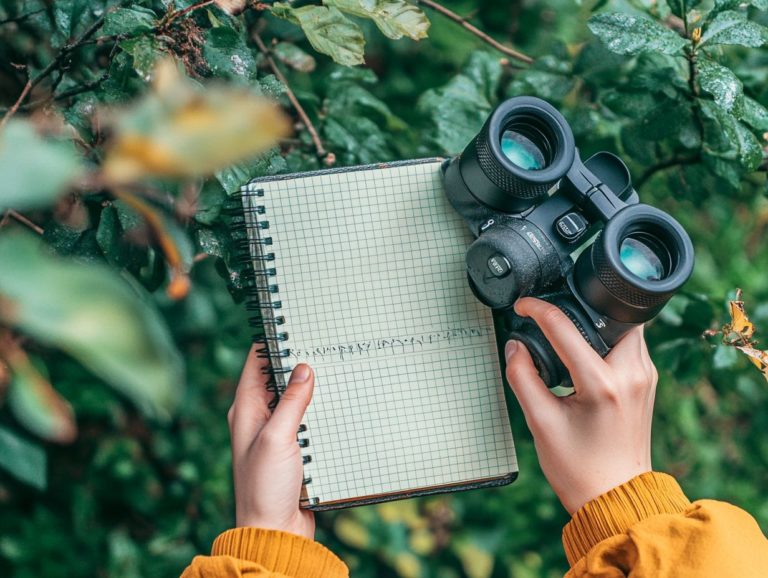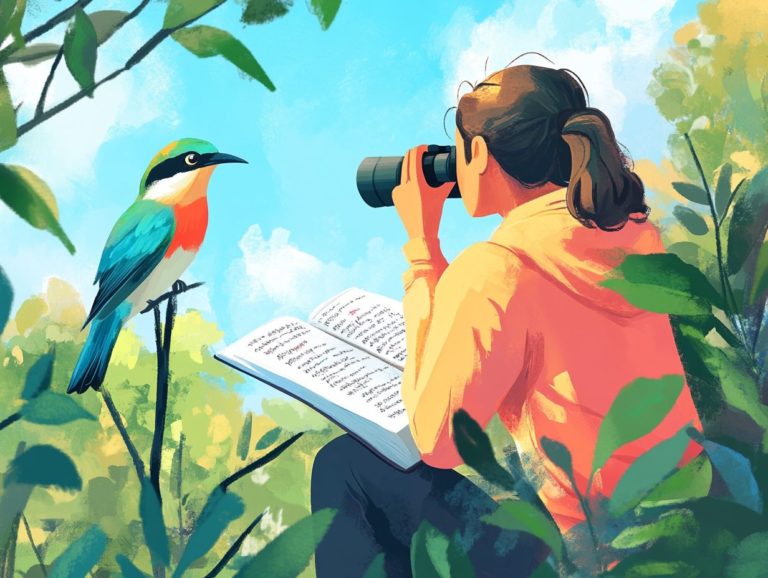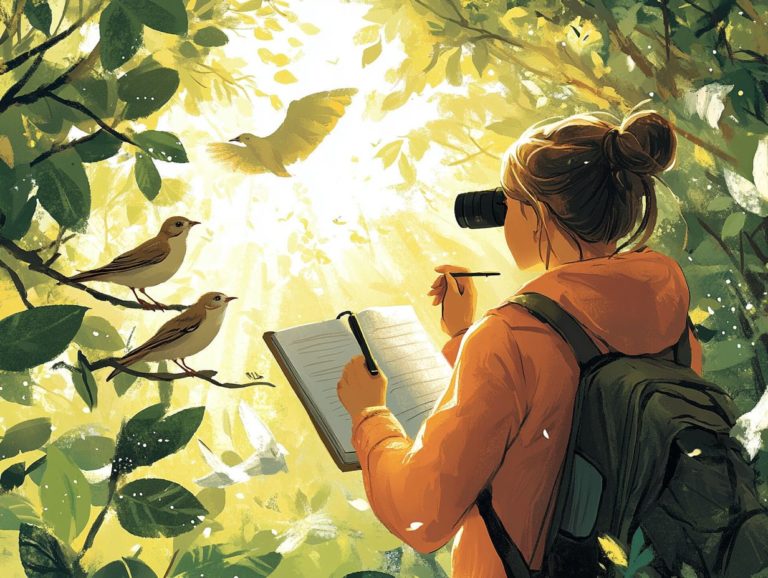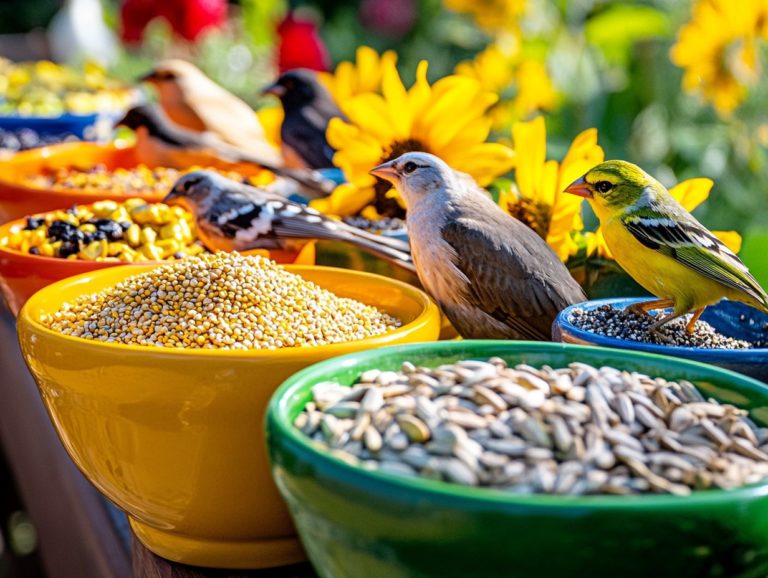How to Record Bird Sounds Effectively?
Recording bird sounds transcends mere hobby status; it s a fulfilling endeavor that allows you to connect deeply with nature and gain valuable insights into avian behavior. You’ll discover captivating songs from birds like the sage thrasher and the Pacific Wren.
Whether you re a bird expert or a casual birdwatcher, capturing these enchanting melodies, including the distinctive calls of the Wood Thrush, will enrich your understanding of the natural world.
Get ready to discover the essential gear and tips for capturing bird sounds like a pro! This article will guide you through the necessary equipment, techniques, and best practices for recording bird sounds effectively, including how to use a parabolic mic for enhanced audio capture.
You ll also learn about common challenges related to background noise and receive editing tips to help you produce stunning audio recordings.
Familiarizing yourself with the legal considerations surrounding eBird submissions and other citizen science initiatives is essential in this captivating pursuit.
Are you ready to embark on your journey into the fascinating realm of bird sound recording? Let s dive in!
Contents
- Key Takeaways:
- Why Record Bird Sounds?
- Equipment and Tools Needed
- Techniques for Recording Bird Sounds
- Common Challenges and How to Overcome Them
- Editing and Enhancing Bird Sound Recordings
- Legal Considerations for Recording Bird Sounds
- Frequently Asked Questions
- How can I effectively record bird sounds?
- Wondering what gear will help you capture those beautiful bird sounds?
- Where is the best location to record bird sounds?
- What time of day is best for recording bird sounds?
- How do I capture the best quality bird sounds?
- What are some tips for recording bird sounds in different environments?
Key Takeaways:
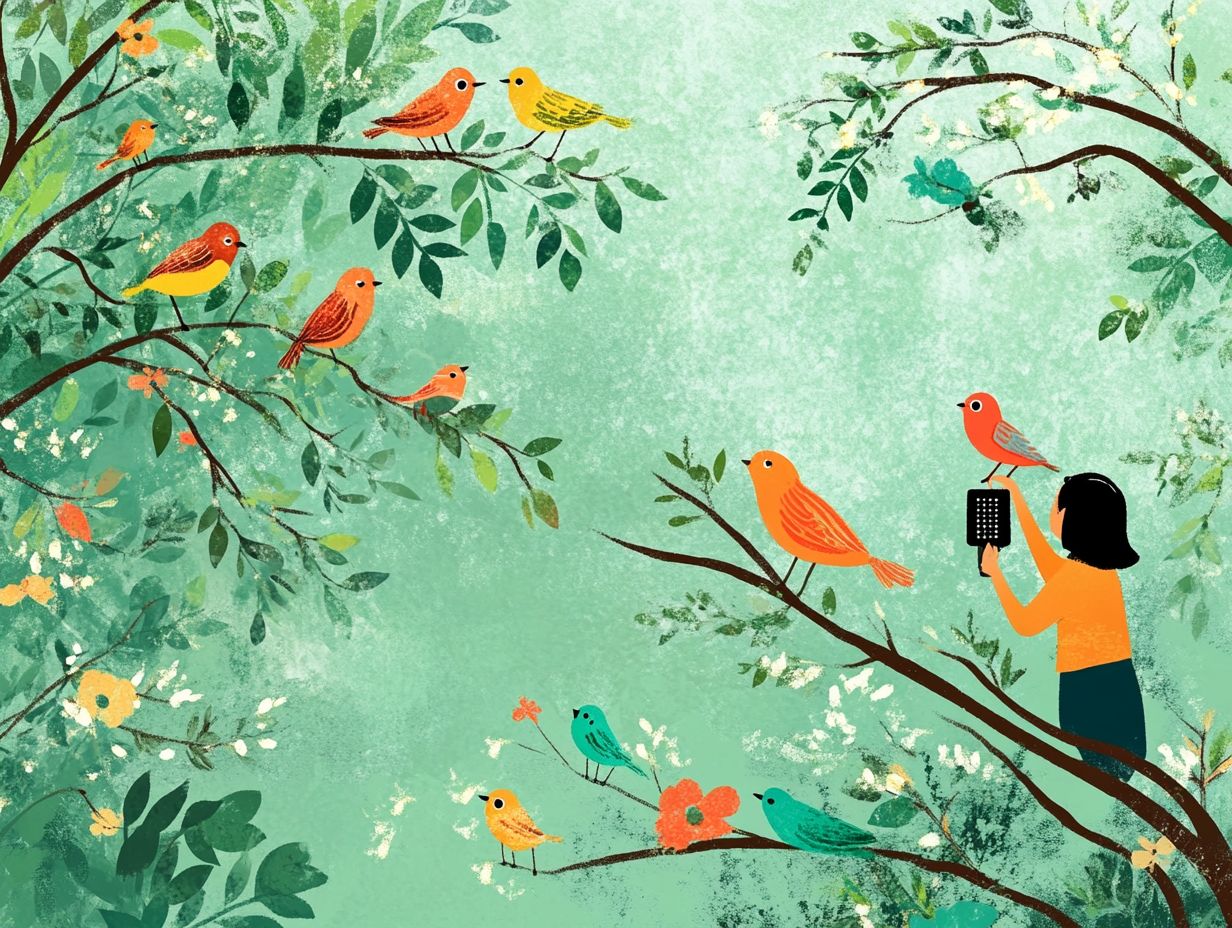
- Record bird sounds for research, education, and conservation purposes, including eBird submissions and contributions to the Macaulay Library.
- Use high-quality microphones, such as the Sennheiser ME66/K6 and the Zoom H4n, along with accessories for better recordings.
- Apply best practices and tips, like selecting quiet locations and utilizing directional microphones to minimize background noise.
Why Record Bird Sounds?
Recording bird sounds serves a multitude of purposes that enrich your understanding of avian species, including the capercaillie and Stellar s Jay, while playing a vital role in citizen science.
This practice enables both bird enthusiasts and researchers to capture bird sounds, track migration patterns, and contribute valuable data to platforms like eBird and the Macaulay Library, thereby enhancing our understanding of avian diversity.
By recording birdsong, you document your experiences and hone your birding skills while enhancing the collective knowledge of local ecosystems, like the Bill Williams River.
Ultimately, this fosters a deeper appreciation for the symphony of wildlife sounds around you.
Purposes and Benefits of Recording
Recording bird sounds offers benefits ranging from personal enjoyment to in-depth scientific research. Each capture provides unique insights into wildlife sounds and the behaviors of various avian species, including the Nutting s Flycatcher.
As you engage with these recordings, you can sharpen your birding skills and improve your technique for capturing bird sounds accurately. Actively listening to the distinctive calls and songs of different birds, like the Wood Thrush and Stellar s Jay, will deepen your understanding of their patterns and characteristics.
This practice not only brings personal satisfaction but also meets educational objectives, allowing both novices and seasoned birdwatchers to share their discoveries and foster a community of bird enthusiasts.
By contributing valuable data to scientific research, including records of bird calls and songs, you play a vital role in tracking population changes and behavioral shifts. Your efforts ultimately support conservation initiatives and cultivate greater appreciation for avian diversity, showcasing the importance of species like the Sage Thrasher in the ecosystem.
Equipment and Tools Needed
To capture exquisite recordings of bird sounds, you need to equip yourself with the right gear, including a directional microphone for delicate sounds.
This means investing in specialized recording tools like directional microphones, such as the R DE Rec and parabolic mic, as well as high-fidelity recorders, including the Sennheiser ME66/K6, Zoom H4n, and Tascam DR-05x.
While many birders appreciate the convenience of smartphone recording with apps like R DE Rec, dedicated equipment often delivers superior sound quality. For an even more refined experience, consider using Telinga s PRO-X, which ensures that delightful avian vocalizations are captured with remarkable clarity while minimizing pesky background noise during your field recordings.
Now that you’re armed with essential information and tools, go out and start recording! Share your experiences and recordings with fellow bird enthusiasts!
Recommended Microphones and Accessories
When capturing bird sounds, certain microphones and accessories, such as shotgun microphones and parabolic mics, stand out as the premier choices for discerning bird watchers and researchers.
These tools elevate audio quality and ensure that even the most delicate calls, like those of the capercaillie, resonate with clarity. Shotgun microphones and parabolic mics are highly recommended for their remarkable ability to pick up sounds from a distance while minimizing background noise. This makes them perfect for capturing the subtle melodies of elusive species. Pairing a shotgun mic with a windscreen drastically reduces wind interference, an essential feature when recording in open areas where wildlife sounds might be affected by environmental factors.
A portable audio recorder, such as the Tascam DR-05x, is an excellent companion that offers high-resolution storage and effortless portability. This allows you to transition seamlessly between locations, ensuring you never miss an opportunity to document nature’s enchanting symphony, including the diverse vocalizations of local avian species.
Techniques for Recording Bird Sounds
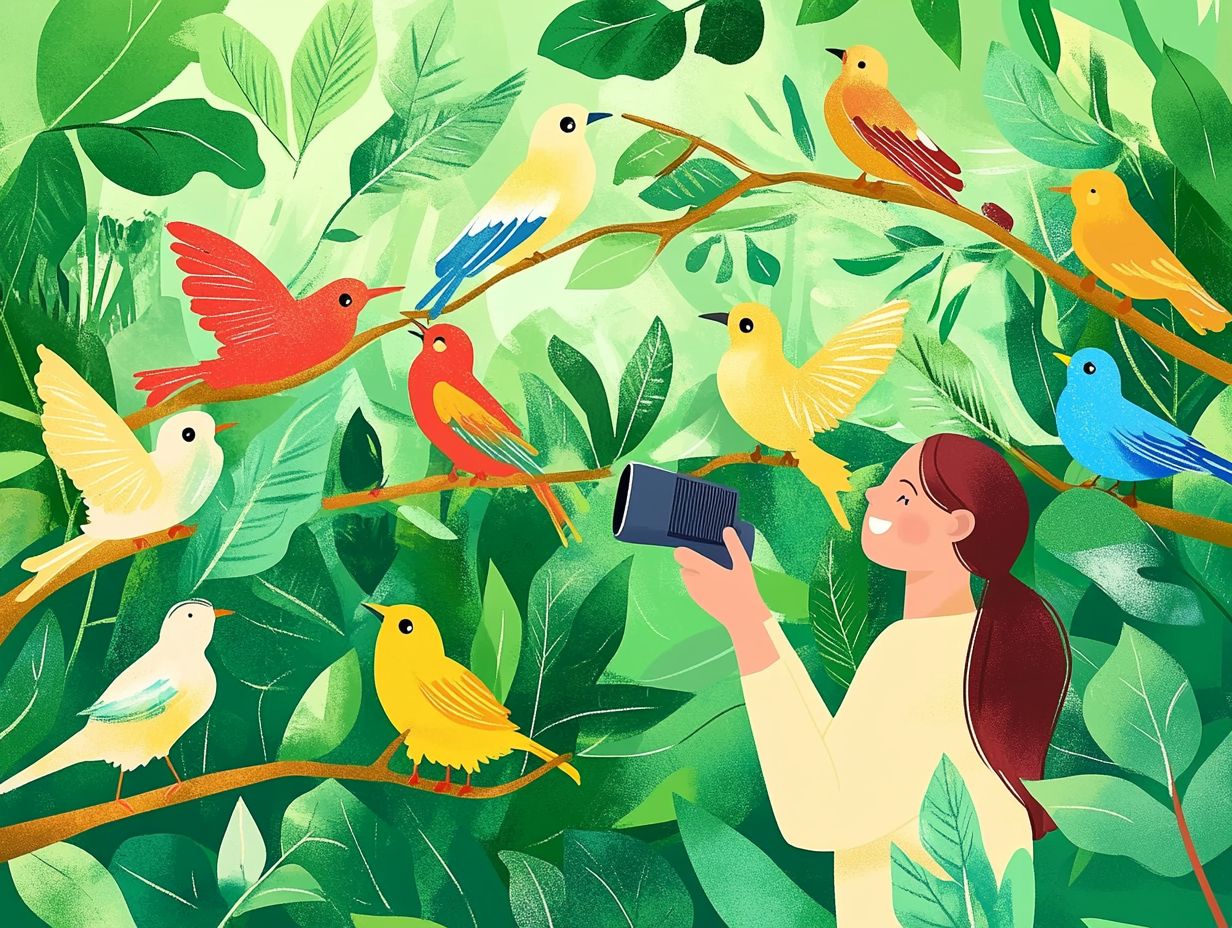
Mastering the art of recording bird sounds requires a clear understanding of specific techniques. These include capturing vocalizations at the right time of day to elevate sound quality and guarantee optimal vocalization capture. Position yourself strategically to minimize background noise while using the right equipment, like directional microphones, to achieve recordings that are both clear and crisp.
Adopt best practices, such as choosing the right time and environment for your recordings. Quiet mornings can significantly enhance the quality of your audio files and enrich the sounds you capture.
Best Practices and Tips
To achieve high-quality recordings of bird sounds, follow best practices that minimize background noise. Use a parabolic mic to optimize your recording environment.
Select the right time of day to enhance recording quality. Early mornings often offer the clearest soundscape with minimal disturbances, perfect for capturing the lively call of the Stellar s Jay. Position yourself away from busy roads or crowded areas to reduce unwanted noise, creating a more immersive experience with wildlife sounds.
Using directional microphones, like shotgun microphones, assists in capturing the nuances of avian calls while filtering out irrelevant sounds. Don t forget to consider factors like wind and humidity, as they can affect audio clarity, especially in field recording. Focus on these elements to create an optimal environment for high-fidelity bird sound recordings, ensuring the sounds of local avian species are captured with remarkable quality.
Common Challenges and How to Overcome Them
Recording bird sounds presents unique challenges, particularly noise interference from environmental factors that muddle the clarity of the wildlife sounds you’re trying to capture. Elements like wind, traffic, and other ambient noises, such as rustling leaves, can greatly affect sound quality.
Recognize potential obstacles and invest in quality recording equipment, like a parabolic mic and directional microphones. This will elevate your recording experience and produce crystal-clear audio files.
Don’t wait! Start your bird recording adventure today!
Noise Interference and Other Obstacles
Noise interference stands as a significant hurdle when it comes to recording bird sounds, where background noise often drowns out the beautiful melodies of wildlife, including the captivating songs of the Wood Thrush.
This challenge isn’t confined solely to bustling urban environments, where the relentless hum of traffic and human activity creates an overwhelming din. It can also occur in serene natural settings. Even in serene natural settings, such as forests and wetlands, you may encounter factors that can distort your recordings. The gentle rustling of wind through leaves, the distant rumble of thunderstorms, or the persistent chatter of insects can all interfere with the clarity of your captures, complicating your field recording efforts.
Mechanical factors, such as handling noise from your microphone or vibrations from your equipment, can make it harder to capture clear wildlife sounds.
To tackle these challenges effectively, use windshields on your microphones, schedule recordings during the quieter hours of the day, like early mornings, or choose locations with good acoustic properties, like remote woodlands. By employing these strategies, you can significantly enhance the clarity of the avian sounds you wish to capture, including the enchanting birdsong of local species, ensuring a more authentic recording experience.
Editing and Enhancing Bird Sound Recordings
Editing and enhancing bird sound recordings is an essential part of your field recording journey, turning raw audio files into stunning recordings that truly capture the beauty of avian vocalizations, allowing you to share your experiences with others.
By utilizing specialized software, you can effectively eliminate unwanted noise, adjust sound levels, and elevate the overall quality of your audio recordings, which makes your submissions to platforms like eBird and the Macaulay Library more impactful. Techniques like noise reduction and equalization (a process to adjust different sound frequencies) are key to making great recordings that not only enrich your collection but also contribute meaningfully to platforms such as eBird and the Macaulay Library, showcasing your dedication to citizen science.
Software and Techniques for Post-Processing

Post-processing bird sound recordings can elevate audio quality and clarity, making it essential for you, whether an enthusiast or a researcher, to select the right software tools like Audubon programs and editing techniques for optimal results.
By exploring various software options, you can uncover features that facilitate noise reduction, allowing you to filter out unwanted sounds while enhancing the natural vocalizations of birds, even the captivating calls of species found in your region. Techniques like equalization can further amplify the vibrancy of your audio, ensuring the essence of the recording remains intact, exemplifying the beautiful soundscapes of avian diversity.
It s also important to choose user-friendly interfaces, as they enable you to navigate complex audio editing tasks with ease, even if you’re a beginner in the realm of bird sound recording. Tools equipped with automation and advanced algorithms can streamline your editing process, ultimately yielding professional-quality recordings that capture the mesmerizing world of avian sounds, showcasing your skill as a bird sound recorder.
Legal Considerations for Recording Bird Sounds
When you set out to record bird sounds, it s vital to keep legal considerations front and center. This means obtaining the necessary permits and familiarizing yourself with local regulations governing wildlife recording.
By complying with wildlife laws, you can contribute meaningfully to citizen science platforms like eBird, all while staying firmly within legal boundaries. Being well-versed in these regulations not only fosters ethical birding practices but also plays a crucial role in protecting avian populations. Recording bird sounds is not just a hobby; it s a chance to make a difference! Stay informed about the laws to protect these beautiful creatures while you record.
Permits and Regulations
Knowing the permits and regulations is your first step to an exciting bird recording adventure! It’s essential for anyone aiming to legally record bird sounds in various locations. Different regions have specific permits tailored to unique wildlife laws, making it crucial for both enthusiasts and professionals to familiarize themselves with local requirements.
For example, national parks often require special permits to safeguard sensitive ecosystems. Following these wildlife laws shows your commitment to responsible recording practices that protect avian habitats.
By being well-informed about these regulations, you can actively contribute to ongoing conservation efforts while relishing the beauty of nature’s symphony. Dive into your local wildlife regulations today and get ready for an adventure!
Description: A captivating video showcasing techniques for recording bird sounds effectively.
Frequently Asked Questions
How can I effectively record bird sounds?
To record bird sounds effectively, you need the right equipment and techniques. Ensure you have a high-quality microphone and a digital recorder. Familiarize yourself with the different sound patterns and behaviors of birds to know when and where to record.
Wondering what gear will help you capture those beautiful bird sounds?

Aside from a microphone and digital recorder, consider using a windscreen to minimize background noise and pops. A tripod or stabilizer will keep your recording device steady, and headphones will help you monitor the sound quality.
Where is the best location to record bird sounds?
The best location to record bird sounds is in a quiet, natural environment where there is a high concentration of birds. Avoid busy streets or areas with loud human activity, as this can interfere with your recordings.
What time of day is best for recording bird sounds?
The ideal time to record bird sounds is early in the morning or late in the evening when birds are most active and vocal. This usually coincides with their feeding times or when they are communicating with each other.
How do I capture the best quality bird sounds?
To capture high-quality bird sounds, position yourself as close as possible to the birds without disturbing them. Use a directional microphone to isolate the sounds of the birds and minimize background noise.
What are some tips for recording bird sounds in different environments?
If you are recording in different environments, such as forests, wetlands, or open fields, research and understand the unique sound patterns and behaviors of the birds in those areas. This knowledge will help you determine the best time and location to record for optimal results.

